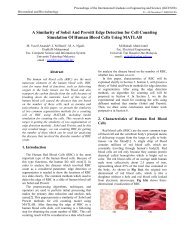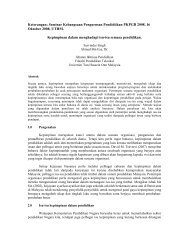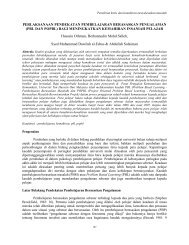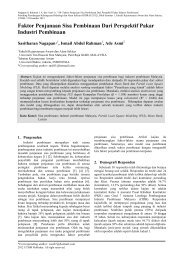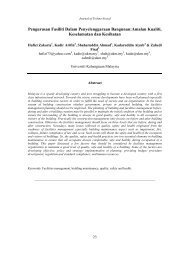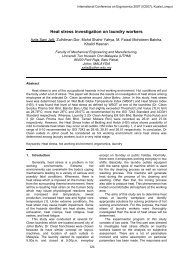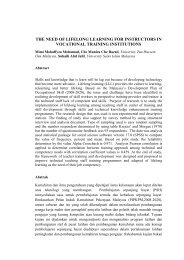Planning Approval Monitoring Groupware (PAMG) for Oil and Gas ...
Planning Approval Monitoring Groupware (PAMG) for Oil and Gas ...
Planning Approval Monitoring Groupware (PAMG) for Oil and Gas ...
You also want an ePaper? Increase the reach of your titles
YUMPU automatically turns print PDFs into web optimized ePapers that Google loves.
International Conference on Engineering, Applied Sciences, <strong>and</strong> Technology<br />
November 21 – 24, 2012, Swissôtel Le Concorde, Bangkok, Thail<strong>and</strong><br />
<strong>Planning</strong> <strong>Approval</strong> <strong>Monitoring</strong> <strong>Groupware</strong> (<strong>PAMG</strong>) <strong>for</strong> <strong>Oil</strong> <strong>and</strong> <strong>Gas</strong> Infrastructure in<br />
Malaysia<br />
Goh, Kai Chen<br />
Senior Lecturer, Department of Construction Management,<br />
Faculty of Technology Management <strong>and</strong> Business<br />
Universiti Tun Hussein Onn Malaysia (UTHM)<br />
Parit Raja, Batu Pahat Malaysia<br />
kaichen@uthm.edu.my<br />
Goh, Hui Hwang<br />
Senior Lecturer, Department of Electrical Power<br />
Engineering, Faculty of Electrical <strong>and</strong> Electronic<br />
Engineering<br />
Universiti Tun Hussein Onn Malaysia (UTHM)<br />
Parit Raja, Batu Pahat Malaysia<br />
hhgoh@uthm.edu.my<br />
Abstract— <strong>Oil</strong> <strong>and</strong> gas infrastructure projects have significant<br />
bearings on their density. As they typically involve complex<br />
processes, especially when dealing with construction projects<br />
planning approval. This situation shows that initiatives <strong>for</strong><br />
improving <strong>and</strong> managing the process become vital. Construction<br />
organisation has begun to realise that knowledge is an intellectual<br />
asset that diffused <strong>and</strong> grew within the organisation in the new<br />
global economy. The need of knowledge management in<br />
construction industry is fueled by the need <strong>for</strong> innovation,<br />
improved business per<strong>for</strong>mance <strong>and</strong> client satisfaction. However,<br />
there is still a need to seek <strong>for</strong> potential of In<strong>for</strong>mation<br />
Technology (IT) as an enabler <strong>for</strong> knowledge management. As a<br />
result, IT application becomes the major focus of this research.<br />
It seeks to look at the use of a web-based technology to improve<br />
the management of planning approval process <strong>for</strong> oil <strong>and</strong> gas<br />
infrastructure projects. This study aims to provide support<br />
during problems reporting, agents’ allocation, planning approval<br />
<strong>and</strong> per<strong>for</strong>mance evaluation. This paper reports the groupware<br />
system that is developed through system development<br />
approaches. As a result, this system serves as an alternative tool<br />
<strong>for</strong> the stakeholders in monitoring, controlling <strong>and</strong> managing<br />
planning approval process during the pre-construction stage.<br />
Keywords- infrastructure; knowledge management;<br />
in<strong>for</strong>mation technology; groupware<br />
I. INTRODUCTION<br />
<strong>Oil</strong> <strong>and</strong> gas infrastructure projects are complex <strong>and</strong> timeconsuming,<br />
which have usually been characterised by their<br />
complexity, diversity <strong>and</strong> the non-st<strong>and</strong>ard nature of the<br />
production [1]. Whatever successful <strong>and</strong> unsuccessful projects<br />
have been executed by the general contractors, a valuable<br />
record of each one should be kept to identify best <strong>and</strong> worst<br />
company practices. During the pre-construction phase of<br />
projects, there are several stages in planning approval of a<br />
project. These stages consist of different local authority <strong>and</strong><br />
consist of different procedures of approval.<br />
An effective means of improving construction<br />
management is crucial to monitor among the approval process.<br />
This improvement helps the stakeholders in knowing about<br />
construction projects in the municipality more quickly,<br />
allowing them to make better in<strong>for</strong>med decisions.<br />
Un<strong>for</strong>tunately, the construction project planning approval<br />
usually takes about six months to ten months. When the<br />
stakeholders are planning <strong>for</strong> the projects, they normally take a<br />
long time in waiting <strong>for</strong> the approval from local authority<br />
without knowing the reasons. This situation hinders<br />
stakeholders to plan future activities of the project.<br />
Most of the data <strong>and</strong> in<strong>for</strong>mation used in construction<br />
projects are stored in paper documents; they include contracts,<br />
specifications, notes, summaries of discussions <strong>and</strong> field<br />
reports. Converting paper documents into electronic versions to<br />
be shared <strong>and</strong> applied in future projects is important <strong>and</strong><br />
necessary in facilitating in<strong>for</strong>mation management <strong>and</strong><br />
supporting the reuse of knowledge. In<strong>for</strong>mation <strong>and</strong> knowledge<br />
associated with a project can then be identified as an active unit<br />
in the project management <strong>and</strong> preserved in a web-based<br />
system that provides the plat<strong>for</strong>m <strong>for</strong> exchanging <strong>and</strong> storing<br />
this in<strong>for</strong>mation <strong>and</strong> knowledge.<br />
Knowledge management is a discipline of identifying,<br />
capturing, retrieving, sharing <strong>and</strong> evaluating an enterprise’s<br />
in<strong>for</strong>mation assets [2, 3]. Knowledge management in<br />
construction projects promotes an integrated approach to<br />
create, capture, assess <strong>and</strong> use of a professional’s domain<br />
knowledge of products, services <strong>and</strong> processes [4]. Knowledge<br />
management concepts can be effectively used during the preconstruction<br />
phase of a project to enable stakeholders to know<br />
about construction projects in the municipality more quickly<br />
<strong>and</strong> allowing them to make better in<strong>for</strong>med decisions about the<br />
future <strong>for</strong> each project.<br />
Latest communication <strong>and</strong> in<strong>for</strong>mation technology (i.e.,<br />
communities of practice <strong>and</strong> chat rooms) can improve<br />
collaboration, coordination <strong>and</strong> in<strong>for</strong>mation exchange between<br />
organisations in construction projects ([5, 6]. They provide a<br />
set of in<strong>for</strong>mation exchange plat<strong>for</strong>ms to support planning,<br />
controlling, managing the decision-making process among<br />
organisations [7]. However, the ability to exchange in<strong>for</strong>mation<br />
from various sources in different <strong>for</strong>mats still remains limited<br />
in current dynamic construction environment. Furthermore, the<br />
in<strong>for</strong>mation constitutes valuable source of knowledge is hardly<br />
transferred among construction stakeholders.<br />
As a result, this research signifies the strength to fill the<br />
knowledge gap of existing research integrating more flexible<br />
knowledge management process with the use of in<strong>for</strong>mation<br />
communication technology. The proposed system creates a<br />
more in<strong>for</strong>mal environment that encourages employees to<br />
monitor, control <strong>and</strong> manage in<strong>for</strong>mation during pre-<br />
79
International Conference on Engineering, Applied Sciences, <strong>and</strong> Technology<br />
November 21 – 24, 2012, Swissôtel Le Concorde, Bangkok, Thail<strong>and</strong><br />
construction stage. The findings of this research enable the<br />
industry to appreciate in<strong>for</strong>mation <strong>and</strong> communication<br />
technology in increasing their business competitiveness.<br />
II.<br />
GROUPWARE DEVELOPMENT PROCESS<br />
The development of a groupware system named <strong>Planning</strong><br />
<strong>Approval</strong> <strong>Monitoring</strong> <strong>Groupware</strong> (<strong>PAMG</strong>) seeks to address the<br />
identified problems. The system focuses in improving<br />
communication between key players in managing the planning<br />
approval process. It explores the IT application that has not<br />
been applied in managing planning approval process. It aims to<br />
provide supports <strong>and</strong> guidelines to the users during fault<br />
reporting, progress of the approval process, job approval <strong>and</strong><br />
per<strong>for</strong>mance evaluation. This system improves the time<br />
prediction of planning approval process <strong>and</strong> job per<strong>for</strong>mance.<br />
The process can be improved through examining previous jobs<br />
of a similar nature <strong>and</strong> agent's per<strong>for</strong>mance. This system also<br />
improves communication between the unit managers, the<br />
agents <strong>and</strong> the staffs in the call centre. It enables quick <strong>and</strong><br />
accurate decision making while managing planning approval<br />
process.<br />
A. System Development<br />
<strong>PAMG</strong> is developed after considering the process analysis<br />
<strong>and</strong> the identified problems during the planning approval<br />
process. The goal is to reduce the problematic components, <strong>and</strong><br />
there<strong>for</strong>e, increase the work, time <strong>and</strong> cost efficiency. The<br />
advancements in in<strong>for</strong>mation <strong>and</strong> communication technology<br />
are seen as the trigger to facilitate this improvement in this<br />
process.<br />
The knowledge acquisition process consisted of meetings<br />
with stakeholders involve in oil <strong>and</strong> gas industry <strong>and</strong> review of<br />
available documents. The first task at the knowledge<br />
acquisition is to decide on the important, most frequently used<br />
<strong>and</strong> problematic planning approval procedures <strong>and</strong> then<br />
concentrate on them, specifically. This involves several<br />
discussions, <strong>and</strong> review of industry documents. In this process,<br />
knowledge <strong>and</strong> in<strong>for</strong>mation are divided into the two categories<br />
such as technical problems <strong>and</strong> non-technical problems. Within<br />
these problems, the knowledge was structured as questions <strong>and</strong><br />
the possible answers. The answer selected would then divert<br />
the system to the next question - in the <strong>for</strong>m of decision trees to<br />
organise the knowledge (Based on questions asked). A number<br />
of repetitions are per<strong>for</strong>med to reach a level of acceptance of<br />
the questions' structure.<br />
Next is the utilisation of the knowledge within the <strong>PAMG</strong><br />
system. Various knowledge-based systems are trailed, such as<br />
XpertRule KBS (Attar, online). However, all the systems used<br />
user friendly based interfaces <strong>and</strong> would not easily fit within a<br />
web enabled system. There<strong>for</strong>e, this research coded the<br />
knowledge decision tree into the web pages of the system.<br />
B. Database Design<br />
Firstly, the database software is chosen, with consideration<br />
given to the system usage. Once the type of database was<br />
selected, then a structure <strong>for</strong> the database is defined. Finally,<br />
the methods <strong>for</strong> the utilisation of the data stored in the database<br />
were developed.<br />
The database selected by a system developer will depend<br />
on the per<strong>for</strong>mance required, such as the speed when h<strong>and</strong>ling<br />
the number of fields used, or the number of records in the<br />
operational database. The number of calls taken by the call<br />
centre will provide the per<strong>for</strong>mance guideline <strong>for</strong> the system's<br />
database. There may be a case <strong>for</strong> an increase in the number of<br />
expected calls to the database once operational, because the<br />
new system allows the unit to check the status of a job more<br />
frequently.<br />
This research employed My SQL to develop the <strong>PAMG</strong><br />
system due to the usage of open source managing tools <strong>and</strong><br />
applied in web. Data stored in the database are retrieved <strong>and</strong><br />
displayed in reports via the web interface. Knowledge from<br />
previous problems of planning approval processes can be used<br />
as reference of new jobs. For example, the <strong>PAMG</strong> system<br />
displays the problems due to designs <strong>and</strong> also other factors, or<br />
the ways that experienced managers in solving the problems. It<br />
provides the plat<strong>for</strong>m that allows the managers to retrieve<br />
in<strong>for</strong>mation as well as ways in dealing problems if they face<br />
the similar problems in the future. The retrieval of previous<br />
jobs of an alike nature can be achieved by using Case Based<br />
Reasoning (CBR).<br />
C. Web Enablement<br />
The system uses the World Wide Web to h<strong>and</strong>le as much of<br />
the communication as possible. The first action was to select a<br />
Web server <strong>and</strong> install the system upon this server.<br />
The server had to have certain software installed:<br />
• Database software – My SQL.<br />
• Software <strong>for</strong> enabling access to the database-<br />
EasyPHP: a complete software package allowing to<br />
use all the power <strong>and</strong> the flexibility that offers the<br />
dynamic language PHP.<br />
• Script languages used by the <strong>Groupware</strong> Open Source<br />
Project Management tool – “dotproject” (PHP)<br />
The web server must have the database software used to<br />
store all the in<strong>for</strong>mation generated during the planning<br />
approval process, because the database will be operational<br />
during the system's periods of activity. ODBC is an application<br />
programming interface that enables applications to access data<br />
in a database management system that uses the Structured<br />
Query Language (MySQL) as its database interaction st<strong>and</strong>ard,<br />
with only relational databases using MySQL. The system's web<br />
pages need to access the database to per<strong>for</strong>m actions.<br />
The web pages interact with the database, retrieve <strong>and</strong> enter<br />
in<strong>for</strong>mation, <strong>and</strong> then structure the resulting viewed web pages<br />
with respect to the results. This is not achievable with web<br />
pages written using only the st<strong>and</strong>ard HyperText Markup<br />
Language (HTML). Data-driven web pages, which pass data<br />
back <strong>and</strong> <strong>for</strong>ward between user <strong>and</strong> system, are required. The<br />
mainstream option is PHP: Hypertext Preprocessor.<br />
PHP pages can be written in any script language, such as:<br />
VBScript (most commonly used), Jscript (JavaScript or<br />
ECMAScript) or Perl, while CGI uses Perl, C, C++ or Java.<br />
The current trend in web development is towards PHP pages<br />
80
International Conference on Engineering, Applied Sciences, <strong>and</strong> Technology<br />
November 21 – 24, 2012, Swissôtel Le Concorde, Bangkok, Thail<strong>and</strong><br />
instead of the ASP (Active Server Pages) method, due to PHP<br />
being easier to develop. PHP was the chosen data-driven<br />
method with VBScript as the major script language <strong>and</strong><br />
JavaScript was used when VBScript was lacking the required<br />
functionality. The final piece in the jigsaw was an opensource<br />
management tool which is a volunteer supported Project<br />
Management application interface from Linux, called<br />
“dotproject” that lets programmers write applications, which<br />
access to a database. “Dotproject” is the code in the PHP pages<br />
that creates the link between the web page <strong>and</strong> the database.<br />
D. System Users <strong>and</strong> Roles<br />
The innovation of <strong>PAMG</strong> lies in its connectivity, i.e.,<br />
connecting all parties using computing network technology.<br />
The communication between the parties is done through the<br />
internet replacing faxes, phones, emails, etc. The use of this<br />
system is controlled through a username <strong>and</strong> password. When<br />
the user logs into the system, the tasks they can per<strong>for</strong>m are<br />
determined by the role of an individual. For example, the top<br />
management can see the per<strong>for</strong>mance of the managers' unit, the<br />
agents <strong>and</strong> the call centres; the managers' unit can see the<br />
per<strong>for</strong>mance of the agents, <strong>and</strong> the call centres, whereas the<br />
call centre operative can only see the per<strong>for</strong>mance of agents.<br />
Hence, the users <strong>for</strong> the system, <strong>and</strong> even more importantly<br />
the actions <strong>and</strong> roles that they per<strong>for</strong>m, had to be defined.<br />
Three main users were defined <strong>for</strong> the planning approval<br />
monitoring system namely top management, unit manager or<br />
engineers, agents, call centre staffs. A system developer user<br />
was also created <strong>for</strong> development purposes.<br />
Different users are allowed to per<strong>for</strong>m distinct functions<br />
when logged into the system. These functions reflect the<br />
responsibilities of various parties currently involved in the<br />
planning approval process.<br />
• The top levels of management staffs are IT skilled.<br />
They use the system to view the per<strong>for</strong>mance of the<br />
planning approval process. Access the per<strong>for</strong>mance of<br />
all other users in the process <strong>and</strong> the jobs in progress or<br />
completed.<br />
• The major task <strong>for</strong> a unit manager or engineer is to<br />
enter new jobs, to check the status of the jobs, to<br />
comment on completed jobs <strong>and</strong> correct any unit detail<br />
errors.<br />
• The agents are authorised to deal with the government<br />
sectors in the planning approval process. They send the<br />
application of planning approval to the government<br />
sectors. They analyse the per<strong>for</strong>mance of the unit, <strong>and</strong><br />
progress of the approval process. As they are facing<br />
problems in the process, they will in<strong>for</strong>m the company<br />
through the call centre.<br />
• The call centre staffs enter the problems <strong>and</strong><br />
in<strong>for</strong>mation as provided by the agents into the system.<br />
They can replicate everything that the unit manager or<br />
the engineer is allowed to per<strong>for</strong>m <strong>and</strong> give a solution<br />
due to the problem occurred. For example, a unit<br />
manager can give solutions <strong>for</strong> the problem that faced<br />
by the agents as stated in the system.<br />
E. System Architecture<br />
<strong>PAMG</strong> system adopted a client <strong>and</strong> server configuration<br />
<strong>and</strong> web-based interface. Figure 1 shows the architecture of the<br />
system. It consists of a server, which runs both as a web server<br />
(<strong>for</strong> hosting the web pages) <strong>and</strong> a database server (<strong>for</strong> h<strong>and</strong>ling<br />
the in<strong>for</strong>mation), <strong>and</strong> many client computers located at various<br />
client's premises. The users interact with the server through a<br />
web-based interface.<br />
Phone<br />
AGENTS<br />
or<br />
Internet<br />
Network<br />
Communication<br />
Media<br />
The connection between the client <strong>and</strong> server can be<br />
achieved through a modem via Internet Network<br />
Communication Media such as an Internet Service Provider<br />
(ISP), Integrated Services Digital Network (ISDN -system that<br />
allows data to be transmitted simultaneously using end-to-end<br />
digital connectivity), or Asymmetric Digital Subscriber Line<br />
(ADSL - a continuously available connection <strong>for</strong> transmitting<br />
digital in<strong>for</strong>mation at a high b<strong>and</strong>width). For some properties<br />
such as public houses were installing a computer is not a<br />
practical option. The unit manager can still contact the<br />
helpdesk using a telephone.<br />
III.<br />
Wide Area<br />
Network<br />
MANAGERS<br />
AND<br />
ENGINEERS<br />
CALL<br />
CENTRE<br />
<strong>PAMG</strong> SYSTEM<br />
KNOWLEDGE<br />
BASED<br />
MODULE<br />
DATABASE<br />
Figure 1. <strong>PAMG</strong> System Architecture<br />
<strong>PAMG</strong> SYSTEM INTERFACE<br />
TOP<br />
MANAGEMENT<br />
This section describes a scenario <strong>for</strong> <strong>PAMG</strong> system<br />
interface <strong>and</strong> operation. The interface of this system is user<br />
friendly. The operation of the system interface is based on a<br />
scenario:<br />
a) A call centre operator received a phone call from the<br />
agent where he faced problem due to the submission of the<br />
drawings are not detailed. Due to this problem, a call centre<br />
operator will logs onto the <strong>PAMG</strong> server using a preallocated<br />
username <strong>and</strong> password to report the problems with<br />
a request <strong>for</strong> solutions.<br />
81
International Conference on Engineering, Applied Sciences, <strong>and</strong> Technology<br />
November 21 – 24, 2012, Swissôtel Le Concorde, Bangkok, Thail<strong>and</strong><br />
government sectors because the planning approvals are all<br />
due to the government sectors. There<strong>for</strong>e, each submission of<br />
planning approval to different departments would be a record<br />
in the system <strong>and</strong> monitored. In each government agency, it<br />
consists of subtasks, which show in Figure 4 is the real task<br />
done by the agents. Here, the call operator will record down<br />
the problems faced by the agents <strong>and</strong> the problem sign ( ! )<br />
will show in the system. Then the managers <strong>and</strong> the engineers<br />
will know that the problem is happening due to the sub tasks<br />
<strong>and</strong> write their comments or solutions to solve the problems.<br />
Figure 2. Overall System Interface<br />
b) At this point, the call centre operator can see the<br />
agents <strong>and</strong> their companies details. The details are sorted by<br />
client, vendor, supplier, consultant, government sector <strong>and</strong><br />
project management company. Besides, this system also<br />
prepared a knowledge based smart search system so that it is<br />
much easier <strong>for</strong> the user to find out the companies name if the<br />
contacts in the system are increasing.<br />
c) In the project field, it shows the project progress <strong>and</strong><br />
also other proposed projects such as in planning project, in<br />
progress project, on-hold project, completed project <strong>and</strong><br />
Gantt chart. From this in<strong>for</strong>mation, It helps the stakeholders<br />
to retrieve the in<strong>for</strong>mation to decide the right action in solving<br />
the problem furthermore monitor the progress of planning.<br />
Besides, this system also shows the Gantt chart of the work so<br />
that the users can direct seen the progress <strong>and</strong> percent done of<br />
each task.(Figure 3)<br />
PROBLEM SIGN (!)<br />
Figure 4. Main Project Task Interface<br />
e) Another <strong>PAMG</strong> function is the file uploading<br />
interface where users can upload any file <strong>for</strong>mat so that other<br />
users can download the file <strong>for</strong> the reference <strong>and</strong> also <strong>for</strong> the<br />
use of application such as the application of planning<br />
approval with the local authorities. The application consists of<br />
different file. There<strong>for</strong>e, it is much easy <strong>for</strong> the engineers <strong>and</strong><br />
managers to print out the <strong>for</strong>ms without going to the<br />
government sectors to get them. (Figure 5).<br />
Figure 3. Project Field Interface<br />
d) Based on the project, the call operator can find out<br />
the task that h<strong>and</strong>les by the agent <strong>and</strong> key-in the problems<br />
faced by the agents into the system. In the task detail interface,<br />
it can be seen that the task of the project is mostly best on the<br />
Figure 5. File Interface<br />
82
International Conference on Engineering, Applied Sciences, <strong>and</strong> Technology<br />
November 21 – 24, 2012, Swissôtel Le Concorde, Bangkok, Thail<strong>and</strong><br />
IV.<br />
CONCLUSION<br />
Process analysis on the process of the planning approval<br />
reveals some important issues that restrain the operation <strong>and</strong><br />
planning in terms of cost <strong>and</strong> time of the projects.<br />
Conventional methods of transferring in<strong>for</strong>mation <strong>and</strong><br />
resolving problems among existing parties have<br />
resulted in poor communication. While some explicit <strong>and</strong><br />
tacit knowledge are left without being fully utilised within the<br />
individuals in the projects. The existing process does not truly<br />
encourage the sharing of knowledge among the parties or<br />
reusing it <strong>for</strong> future projects. Instead, it produces considerably<br />
static in<strong>for</strong>mation that not only lacks flexibility in providing<br />
useful in<strong>for</strong>mation <strong>for</strong> monitoring the planning approval<br />
procedures but also does not generate vital analysis <strong>for</strong> future<br />
reference.<br />
In<strong>for</strong>mation <strong>and</strong> communication technology tools that<br />
support knowledge management can be divided into two, <strong>for</strong><br />
example, tools <strong>for</strong> managing tacit knowledge <strong>and</strong> tools <strong>for</strong><br />
managing explicit knowledge. However, both are dominated by<br />
the advanced technology of networking such as the Internet,<br />
intranet or extranet. Networking enhances the functionalities of<br />
these tools which technically are meant <strong>for</strong> organising,<br />
applying, communicating or sharing the knowledge.<br />
The problems unearthed in the process analysis have<br />
opened an opportunity <strong>for</strong> improvement. The main concern is<br />
improving the management of knowledge, communication,<br />
in<strong>for</strong>mation flow <strong>and</strong> data sharing by eliminating some<br />
unnecessary routines in the process. Hence, planning <strong>for</strong> the<br />
petrol stations projects could benefit from a system that allows<br />
the acquisition, storage, distribution <strong>and</strong> reuse of knowledge.<br />
The system permits all parties to access the system to update,<br />
share <strong>and</strong> retrieve in<strong>for</strong>mation stored in the server with a<br />
certain level of access control.<br />
The main idea of the <strong>PAMG</strong> system is to bring all the<br />
different parties to share in<strong>for</strong>mation <strong>and</strong> communicate on a<br />
common interface with pre-allocated password access as a<br />
control mechanism that will limit each user to its role in the<br />
planning approval process. The knowledge management side of<br />
it allows the system to create new knowledge; store the<br />
knowledge <strong>for</strong> any authorised person who may need it; use the<br />
knowledge when necessary; <strong>and</strong> disseminate the knowledge. In<br />
addition, it is also able to guide the users through the decisionmaking<br />
process.<br />
ACKNOWLEDGMENT<br />
The authors express gratefully acknowledgment to the<br />
industry stakeholders <strong>for</strong> their valuable contributions towards<br />
the success of this research. This research is fully funded by<br />
Universiti Tun Hussein Onn Malaysia (UTHM) under Vot:<br />
0929, Short Term Grant (STG) Phase 3/2011.<br />
REFERENCES<br />
[1] P. Carrillo, "Managing knowledge: lessons from the oil <strong>and</strong> gas sector,"<br />
Construction Management <strong>and</strong> Economics, vol. 22, pp. 631-642, 2004.<br />
[2] L. Kanapeckiene, A. Kaklauskas, E. Zavadskas, <strong>and</strong> M. Seniut,<br />
"Integrated knowledge management model <strong>and</strong> system <strong>for</strong> construction<br />
projects," Engineering Applications of Artificial Intelligence, vol. 23,<br />
pp. 1200-1215, 2010.<br />
[3] Y. Rezgui, C. J. Hopfe, <strong>and</strong> C. Vorakulpipat, "Generations of knowledge<br />
management in the architecture, engineering <strong>and</strong> construction industry:<br />
An evolutionary perspective," Advanced Engineering In<strong>for</strong>matics, vol.<br />
24, pp. 219-228, 2010.<br />
[4] A. Styhre, Managing knowledge in the construction industry: The cases<br />
of construction work <strong>and</strong> architecture: London&New York Spon Press,<br />
2009.<br />
[5] T. M. Froese, "The impact of emerging in<strong>for</strong>mation technology on<br />
project management <strong>for</strong> construction," Automation in Construction, vol.<br />
19, pp. 531-538, 2010.<br />
[6] E. Jaselskis, J. Ruwanpura, T. Becker, L. Silva, P. Jewell, <strong>and</strong> E. Floyd,<br />
"Innovation in Construction Engineering Education Using Two<br />
Applications of Internet‐Based In<strong>for</strong>mation Technology to Provide<br />
Real‐Time Project Observations," Journal of Construction Engineering<br />
<strong>and</strong> Management, vol. 1, p. 202, 2010.<br />
[7] H. Ping Tserng <strong>and</strong> Y. C. Lin, "Developing an activity-based knowledge<br />
management system <strong>for</strong> contractors," Automation in Construction, vol.<br />
13, pp. 781-802, 2004<br />
83




